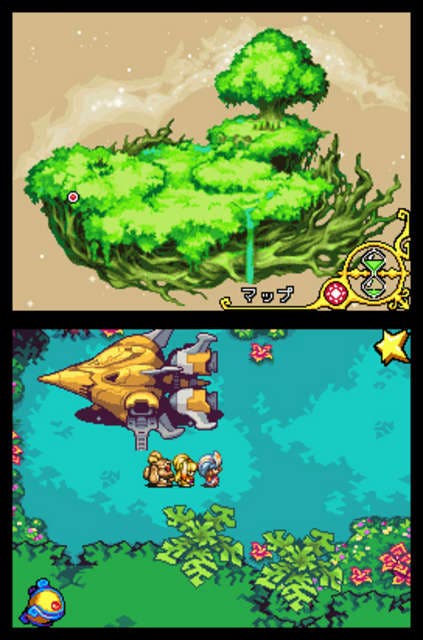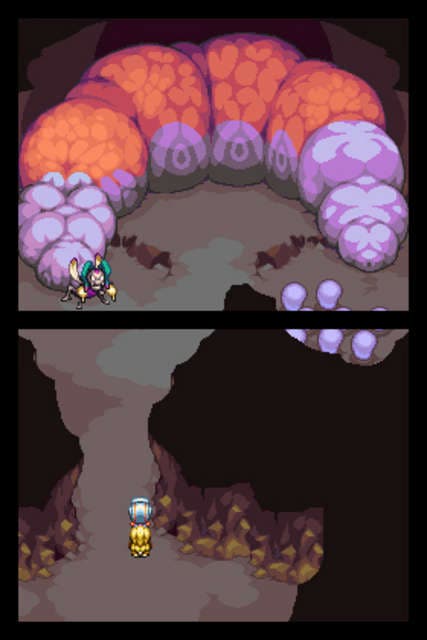Magical Starsign
A fortuitous alignment of DS and RPG.
Given the fact that the Nintendo DS is enormously popular in its native land of Japan, it's really quite surprising that the turn-based RPG is so badly under represented on the system.
Certainly, we understand that the brain trainers and the dog lovers who bought it to poke virtual puppies probably aren't that bothered about playing RPGs. But nevertheless, this is still the country where Dragon Quest and Final Fantasy have ruled the gaming charts with an iron fist for two decades. You'd think that by now, its best selling console in years would have been graced with more than the token handful of decent RPG efforts we've seen.
Magical Starsign is the latest game to attempt to redress this balance, and, perhaps surprisingly, it's actually a bloody good attempt. The sequel to a GBA title which never popped up in the West, it's a game of hidden depths. It's one whose appeal will take in both younger audiences, and older players who are willing to surrender to the saccharine-sweet presentation for long enough to get hooked on the genuinely excellent gameplay.
Star Trekking

The game kicks off when you and your classmates - a motley bunch of Saturday morning cartoon types - discover that your teacher has gone missing on a trip to another planet. Rather than sitting around enjoying the inevitable free periods, though, you decide to hijack the school's fleet of rocket ships, as you do. And with that, it's off around the cosmos with the whole crew, stopping off on the various planets of the system as you hunt for your estranged teacher and encounter some of the weirder inhabitants of the developers' twisted imagination along the way.
So far, so twee. There's little doubt that much of the plot really is old hat, the sort of thing which is highly unlikely to keep anyone above the age of about 12 engrossed in the game. That said, there are moments of genius in there as well, reminiscent of those jokes in kids cartoons which are obviously designed to appeal to adults, and would sail right over the heads of the core audience of little tykes. We especially liked the revelation that the Space Police Force has actually been consumed so much by bureaucracy that it no longer actually fights crime; it just fills out forms. Elsewhere, there's a much-trumpeted mystical sage whose appearance is surreal and off-the-wall enough that you half expect to see Noel Fielding's face grinning from the scenery somewhere.The humour thankfully carries through into some of the well-written dialogue, and is enough to haul Magical Starsign's plot out of the waters of obscurity by the scruff of its neck.
The rest of the presentation is generally pretty good, though. The visuals are pretty heavily focused on primary colours, as you might expect, but each planet has a theme of its own which works well, and there's plenty of imagination on display in the monsters and character designs. Meanwhile, the music is excellent in battle scenes, if a bit nondescript elsewhere, and although the soundtrack is somewhat limited in scope it never becomes annoying or repetitive.
Zodiac Brave

Where Magical Starsign really comes to life is in its core gameplay, which boasts not only a great battle system, but also a control setup which truly takes advantage of the DS' strengths. While previous RPGs on the console have paid lip service to the touchscreen and dual-screen capabilities of the DS, Magical Starsign embraces both. It dispenses almost entirely with the face buttons in favour of stylus control, and this is used not only to select commands in battle, but also to navigate around the screen and to trigger special abilities to solve puzzles in the field. The top screen, meanwhile, is used often to continue the scenery below, but can be flipped over to a variety of status screens - some of which carry information which is extremely useful to have in front of you in battle.
In terms of the battle mechanics, the game employs a turn-based system which stacks up elemental attacks on a fairly simple-looking Rock-Paper-Scissors basis. Water beats fire, fire beats wood, and so on around in a circle of five elements, each element being weak against one other, and strong against one other. Attacking using the right element is crucial, and each of the five members of your party has a specific element associated with them. However, there's another layer to the complexity of the element system, and that's Auras.
One of the menu screens is the Astrolog, a chart which shows the location of each of the five planets (five planets, five elements) in the system. When a planet is in the sector which corresponds with its element, that element gains a major power boost (you can see this on the battle screen as an Aura, when a character of the relevant element starts to glow). Their attacks do much more damage at this point, even to the extent of doing fairly significant damage to enemies who aren't of the opposing element.
If that isn't complex enough, then there's the issue of the central character; your avatar in the game, whose gender and alignment you select at the start. The alignment is either Light or Dark; two special elements which sit outside the normal five, and which simply do enhanced damage to one another, and normal damage to the five regular elements. The complexity of Light and Dark comes from the fact that they, too, have auras, with Light alignment players and monsters gaining an aura during the day, and Dark alignment gaining an aura at night. The Day-Night cycle runs on a 20 minute clock, and often you'll find that it's much better to wait until it favours you before taking on a tricky boss character, since battling at the right time of day, with the planets in the right alignment, can be the difference between winning and losing.
Mana Tap

If you've got your head around that system, there are two more layers to the battle system in Magical Starsign which are worthy of mention. The first is a straightforward mechanic where a carefully timed tap on a character casting a spell can boost the power of that spell significantly; the more precise the timing, the better the effect is. This gives the game almost a rhythm-action kind of feel, and lends a little more action to the turn-based battles.
The other interesting system is the presence of a front and back row for your characters. While this is not exactly an innovation in itself, the effect is more pronounced in Magical Starsign than in many other games. Characters in the back row cannot perform melee attacks, and their magical attacks are spread out over all of the enemies on screen, but in return, their defence is much better, so helps balance where you put your various characters depending on their role and elemental abilities.
If all of this sounds quite complex, then that's because it is - but at no point in the game does the complexity ever feel overwhelming or excessive. Each new element is introduced gradually and by the time you actually need to be using it properly to win battles, you'll find it almost completely intuitive, not least because of the wonderful control system which makes sure that everything you need to do is available with a tap of the stylus. This is a game designed to be perfectly friendly to children, while at the same time providing enough complexity to keep adults intrigued. It's perhaps telling that while you can finish the game comfortably within 20 hours, there's also plenty of extra content there to tax players who really want to master the battle system.

The game isn't without its flaws, mind you. We did find that on occasion, navigating with the stylus could be a little dodgy, but it never caused any serious frustrations, while the encounter rate for the battles is frankly a bit too high for our tastes. The magic animations are also surprisingly long (and annoyingly unskippable) for a game in which pretty much all of the useful attacks are magical rather than physical. In combination with the high encounter rate, that can rankle at times, especially given the extent to which the plot uses dull fetch-quests as a crutch to keep the play-time up.
Planetary Alignment
Magical Starsign is clearly not going to be an RPG for everyone. This brand of saccharine presentation (even when dosed with a little surreal humour) will be hugely off-putting to many game fans. The high encounter rate and strictly turn-based battle system are also a little traditional for anyone raised on fare like the more recent Final Fantasies. But for those who like (or are simply willing to accept) these aspects, this is arguably one of the best RPGs currently available for the DS.
It may not have the production values of Final Fantasy III, but Magical Starsign combines a superb and intriguing battle system with a genuinely fresh look at how to control this kind of game on the DS. The result is something which is well worth a look for any RPG fan who's in the market for a handheld adventure.








